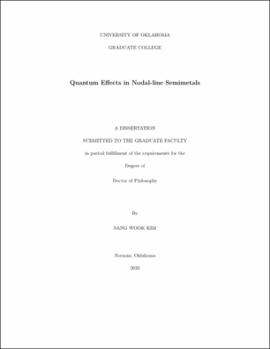| dc.contributor.advisor | Uchoa, Bruno | |
| dc.contributor.author | Kim, Sang Wook | |
| dc.date.accessioned | 2020-07-30T15:13:04Z | |
| dc.date.available | 2020-07-30T15:13:04Z | |
| dc.date.issued | 2020 | |
| dc.identifier.uri | https://hdl.handle.net/11244/325323 | |
| dc.description.abstract | Topological materials such as Dirac and Weyl semimetals have relativistic quasiparticles at a discrete number of points in the Brillouin zone. Those materials are semimetalas in the bulk but host metallic surface states that are protected by either symmetries or topological invariants. This thesis is about a class of quantum materials known as nodal line semimetals (NLSM), which have relativistic quasiparticles forming along lines. In three dimensions (3D), there are three types of crystalline symmetries that protect NLSMs. They can be classified by a combination of those symmetries which are inversion and time reversal symmetry, mirror reflection symmetry, and non-symmorphic symmetry.
In this thesis, we address various 3D Hall effects in a lattice realization of a NLSM known as the hyperhoneycomb lattice. We specifically address the 3D anomalous quantum Hall effect, which occurs through a topological quantum phase transition where the nodal line is gapped out by a Haldane mass. Because of the symmetry of the Haldane mass, the gap closes at a discrete number of points, which form Weyl points connected to each other through topological Fermi arcs. We also examine elastic gauge fields in the hyperhoneycomb lattice that generate nearly flat Landau levels in 3D. We propose a family of strain deformations that can be plausibly implemented with temperature gradients. In the 3D QAH phase, we also calculate dissipationless elastic Hall viscosity tensor.
In the last part, we address the hydrodynamics of relativistic quasiparticles in NLSMs. Hydrodynamics describes the universal behavior of quantum systems when transport is dominated by the collision between particles. It describes the long wavelength deviation of a quantum fluid from local thermal equilibration. We derive electrical conductivity and shear viscosity in the hydrodynamic regime by solving the quantum Boltzmann equation. In general, the lower the ratio between the shear viscosity and the entropy, the more strongly correlated a quantum system is expected to be. We show that the ratio between the shear viscosity and the entropy in NLSMs violates a conjectured lower bound applicable to ultra-correlated quantum systems. We show that both the longitudinal conductivity and the viscosity-entropy ratio scale to zero at low temperature T, in contrast with relativistic systems in general, where the latter saturates to a constant, or Fermi liquids where \eta/s diverges at low T. We propose that the conjectured lower bound should be revisited to account for unscreened relativistic systems with a Fermi surface. | en_US |
| dc.language | en_US | en_US |
| dc.rights | Attribution-NonCommercial-NoDerivatives 4.0 International | * |
| dc.rights.uri | https://creativecommons.org/licenses/by-nc-nd/4.0/ | * |
| dc.subject | Quantum Hall effect | en_US |
| dc.subject | Topological material | en_US |
| dc.subject | Nodal-line semimetals | en_US |
| dc.subject | Hydrodynamics | en_US |
| dc.title | Quantum Effects in Nodal-line Semimetals | en_US |
| dc.contributor.committeeMember | Przebinda, Tomasz | |
| dc.contributor.committeeMember | Santos, Michael | |
| dc.contributor.committeeMember | Marino, Alberto | |
| dc.contributor.committeeMember | Mullen, Kieran | |
| dc.date.manuscript | 2020-07-29 | |
| dc.thesis.degree | Ph.D. | en_US |
| ou.group | College of Arts and Sciences::Homer L. Dodge Department of Physics and Astronomy | en_US |
| shareok.orcid | https://orcid.org/0000-0003-0382-0648 | en_US |
| shareok.nativefileaccess | restricted | en_US |

